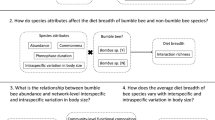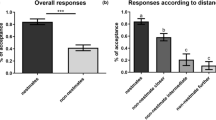Abstract
In the honeybee swarm nest-site selection process, individual bees gather information about available candidate sites and communicate the information to other bees. The swarm makes an agreement for a candidate site when the number of bees that supports the site reaches a threshold. This threshold is usually referred to as the quorum threshold and it is shown by many studies as a key parameter that is a compromise between the accuracy and speed of decisions. In the present work, we use a model of the honeybee Apis mellifera nest-site selection process to study how the quorum threshold and discovery time of candidate sites have major impact on two unfavorable situations in selecting a nest site: decision deadlock and decision split. We show that cross-inhibitory stop-signaling, delivered among bees supporting different sites, enables swarms to avoid the decision split problem in addition to avoiding the decision deadlock problem that has been previously proposed. We also show that stop-signaling improves decision speed, but compromises decision accuracy in swarms using high quorum thresholds by causing the swarms to be trapped in local optima (e.g., choosing a sub-optimal option that is encountered first). On the other hand, we demonstrate that stop-signaling can reduce split decisions without compromising decision accuracy in swarms using low quorum thresholds when it is compared to the accuracy of swarms using the same threshold values but not exhibiting stop-signaling. Based on our simulations, we suggest that swarms using low quorum thresholds (as well as swarms with large population sizes) would benefit more from exhibiting the stop-signaling activity than not exhibiting it.





Similar content being viewed by others
References
Bogacz R, Brown E, Moehlis J, Holmes P, Cohen JD (2006) The physics of optimal decision making: a formal analysis of models of performance in two-alternative forced-choice tasks. Psychol Rev 113:700–765. doi:10.1037/0033-295X.113.4.700
Chittka L, Dyer AG, Bock F, Dornhaus A (2003) Psychophysics: bees trade off foraging speed for accuracy. Nature 424:388–388. doi:10.1038/424388a
Chittka L, Skorupski P, Raine NE (2009) Speed–accuracy tradeoffs in animal decision making. Trends Ecol Evol 24:400–407. doi:10.1016/j.tree.2009.02.010
Couzin ID (2009) Collective cognition in animal groups. Trends Cogn Sci 13:36–43. doi:10.1016/j.tics.2008.10.002
Czaczkes TJ (2014) How to not get stuck—negative feedback due to crowding maintains flexibility in ant foraging. J Theor Biol 360:172–180. doi:10.1016/j.jtbi.2014.07.005
Czaczkes TJ, Grüter C, Ellis L, Wood E, Ratnieks FLW (2013a) Ant foraging on complex trails: route learning and the role of trail pheromones in Lasius niger. J Exp Biol 216:188–197. doi:10.1242/jeb.076570
Czaczkes TJ, Grüter C, Ratnieks FLW (2013b) Negative feedback in ants: crowding results in less trail pheromone deposition. J R Soc Interface 10. doi:10.1098/rsif.2012.1009
Czaczkes TJ, Salmane AK, Klampfleuthner FAM, Heinze J (2016) Private information alone can trigger trapping of ant colonies in local feeding optima. J Exp Biol 219:744–751. doi:10.1242/jeb.131847
Dyer FC (2002) The biology of the dance language. Annu Rev Entomol 47:917–949. doi:10.1146/Annurev.Ento.47.091201.145306
Dyer JR, Ioannou CC, Morrell LJ, Croft DP, Couzin ID, Waters DA, Krause J (2008) Consensus decision making in human crowds. Anim Behav 75:461–470. doi:10.1016/j.anbehav.2007.05.010
Franks NR, Dornhaus A, Fitzsimmons JP, Stevens M (2003) Speed versus accuracy in collective decision making. Proc R Soc B 270:2457–2463. doi:10.1098/rspb.2003.2527
Franks NR et al. (2013) Speed–cohesion trade-offs in collective decision making in ants and the concept of precision in animal behaviour. Anim Behav 85:1233–1244. doi:10.1016/j.anbehav.2013.03.010
Gillespie DT (2007) Stochastic simulation of chemical kinetics. Annu Rev Phys Chem 58:35–55. doi:10.1146/annurev.physchem.58.032806.104637
Jack-McCollough RT, Nieh JC (2015) Honeybees tune excitatory and inhibitory recruitment signalling to resource value and predation risk. Anim Behav 110:9–17. doi:10.1016/j.anbehav.2015.09.003
Janson S, Middendorf M, Beekman M (2007) Searching for a new home - scouting behavior of honeybee swarms. Behav Ecol 18:384–392. doi:10.1093/beheco/arl095
Johnson BR, Nieh JC (2010) Modeling the adaptive role of negative signaling in honey bee intraspecific competition. J Insect Behav 23:459–471. doi:10.1007/s10905-010-9229-5
Kietzman PM, Visscher PK (2015) The anti-waggle dance: use of the stop signal as negative feedback. Front Ecol Evol 3:14. doi:10.3389/fevo.2015.00014
Laomettachit T, Termsaithong T, Sae-Tang A, Duangphakdee O (2015) Decision-making in honeybee swarms based on quality and distance information of candidate nest sites. J Theor Biol 364:21–30. doi:10.1016/j.jtbi.2014.09.005
Lau CW, Nieh JC (2010) Honey bee stop-signal production: temporal distribution and effect of feeder crowding. Apidologie 41:87–95. doi:10.1051/apido/2009052
Lindauer M (1961) Communication among social bees. Harvard University Press, Cambridge
Marshall JAR, Dornhaus A, Franks NR, Kovacs T (2006) Noise, cost and speed-accuracy trade-offs: decision-making in a decentralized system. J R Soc Interface 3:243–254. doi:10.1098/rsif.2005.0075
Marshall JAR, Bogacz R, Dornhaus A, Planque R, Kovacs T, Franks NR (2009) On optimal decision-making in brains and social insect colonies. J R Soc Interface 6:1065–1074. doi:10.1098/rsif.2008.0511
Masuda N, O’shea-Wheller TA, Doran C, Franks NR (2015) Computational model of collective nest selection by ants with heterogeneous acceptance thresholds. R Soc Open Sci 2:140533. doi:10.1098/rsos.140533
Nieh JC (2010) A negative feedback signal that is triggered by peril curbs honey bee recruitment. Curr Biol 20:310–315. doi:10.1016/j.cub.2009.12.060
Niven JE (2012) How honeybees break a decision-making deadlock. Science 335:43–44. doi:10.1126/science.1216563
Pais D, Hogan PM, Schlegel T, Franks NR, Leonard NE, Marshall JAR (2013) A mechanism for value-sensitive decision-making. PLoS One 8:e73216. doi:10.1371/journal.pone.0073216
Passino KM, Seeley TD (2006) Modeling and analysis of nest-site selection by honeybee swarms: the speed and accuracy trade-off. Behav Ecol Sociobiol 59:427–442. doi:10.1007/s00265-005-0067-y
Passino KM, Seeley TD, Visscher PK (2008) Swarm cognition in honey bees. Behav Ecol Sociobiol 62:401–414. doi:10.1007/s00265-007-0468-1
Perdriau BS, Myerscough MR (2007) Making good choices with variable information: a stochastic model for nest-site selection by honeybees. Biol Lett 3:140–143. doi:10.1098/rsbl.2006.0599
Pirrone A, Stafford T, Marshall JAR (2014) When natural selection should optimize speed-accuracy trade-offs. Front Neurosci 8:73. doi:10.3389/fnins.2014.00073
Pratt SC, Mallon EB, Sumpter DJ, Franks NR (2002) Quorum sensing, recruitment, and collective decision-making during colony emigration by the ant Leptothorax albipennis. Behav Ecol Sociobiol 52:117–127. doi:10.1007/s00265-002-0487-x
Price RIA, Grüter C, Hughes WOH, Evison SEF (2016) Symmetry breaking in mass-recruiting ants: extent of foraging biases depends on resource quality. Behav Ecol Sociobiol:1–8. doi:10.1007/s00265-016-2187-y
Reina A, Valentini G, Fernández-Oto C, Dorigo M, Trianni V (2015) A design pattern for decentralised decision making. PLoS One 10:e0140950. doi:10.1371/journal.pone.0140950
Schaerf TM, Makinson JC, Myerscough MR, Beekman M (2013) Do small swarms have an advantage when house hunting? The effect of swarm size on nest-site selection by Apis mellifera. J R Soc Interface 10:20130533. doi:10.1098/rsif.2013.0533
Schürch R, Couvillon MJ, Burns DDR, Tasman K, Waxman D, Ratnieks FLW (2013) Incorporating variability in honey bee waggle dance decoding improves the mapping of communicated resource locations. J Comp Physiol A 199:1143–1152. doi:10.1007/s00359-013-0860-4
Seeley TD (2010) Honeybee democracy. Princeton University Press, Princeton
Seeley TD, Buhrman SC (1999) Group decision making in swarms of honey bees. Behav Ecol Sociobiol 45:19–31. doi:10.1007/s002650050536
Seeley TD, Buhrman SC (2001) Nest-site selection in honey bees: how well do swarms implement the "best-of-N″ decision rule? Behav Ecol Sociobiol 49:416–427. doi:10.1007/s002650000299
Seeley TD, Visscher PK (2003) Choosing a home: how the scouts in a honey bee swarm perceive the completion of their group decision making. Behav Ecol Sociobiol 54:511–520. doi:10.1007/s00265-003-0664-6
Seeley TD, Visscher PK (2004a) Group decision making in nest-site selection by honey bees. Apidologie 35:101–116. doi:10.1051/apido:2004004
Seeley TD, Visscher PK (2004b) Quorum sensing during nest-site selection by honeybee swarms. Behav Ecol Sociobiol 56:594–601. doi:10.1007/s00265-004-0814-5
Seeley TD, Visscher PK, Passino KM (2006) Group decision making in honey bee swarms. Am Sci 94:220–229
Seeley TD, Visscher PK, Schlegel T, Hogan PM, Franks NR, Marshall JAR (2012) Stop signals provide cross inhibition in collective decision-making by honeybee swarms. Science 335:108–111. doi:10.1126/science.1210361
Stewart KJ, Harcourt AH (1994) Gorillas’ vocalizations during rest periods: signals of impending departure? Behaviour 130:29–40. doi:10.1163/156853994X00127
Stroeymeyt N, Giurfa M, Franks NR (2010) Improving decision speed, accuracy and group cohesion through early information gathering in house-hunting ants PLoS One 5:e13059 doi:10.1371/journal.pone.0013059
Sueur C, Deneubourg J-L, Petit O (2010) Sequence of quorums during collective decision making in macaques. Behav Ecol Sociobiol 64:1875–1885. doi:10.1007/s00265-010-0999-8
Sumpter DJT, Beekman M (2003) From nonlinearity to optimality: pheromone trail foraging by ants. Anim Behav 66:273–280. doi:10.1006/anbe.2003.2224
Sumpter DJT, Pratt SC (2009) Quorum responses and consensus decision making. Philos Trans R Soc B 364:743–753. doi:10.1098/rstb.2008.0204
Sumpter DJT, Krause J, James R, Couzin ID, Ward AJW (2008) Consensus decision making by fish. Curr Biol 18:1773–1777. doi:10.1016/j.cub.2008.09.064
Thorpe S, Fize D, Marlot C (1996) Speed of processing in the human visual system. Nature 381:520–522. doi:10.1038/381520a0
Valentini G, Hamann H, Dorigo M (2015) Efficient decision-making in a self-organizing robot swarm: on the speed versus accuracy trade-off. In: Proceedings of the 2015 International Conference on Autonomous Agents and Multiagent Systems, International Foundation for Autonomous Agents and Multiagent Systems, pp 1305–1314
Visscher PK (2007) Group decision making in nest-site selection among social insects. Annu Rev Entomol 52:255–275. doi:10.1146/annurev.ento.51.110104.151025
Visscher PK, Camazine S (1999) Collective decisions and cognition in bees. Nature 397:400–400. doi:10.1038/17047
Ward AJW, Sumpter DJT, Couzin ID, Hart PJB, Krause J (2008) Quorum decision-making facilitates information transfer in fish shoals. Proc Natl Acad Sci U S A 105:6948–6953. doi:10.1073/pnas.0710344105
Wickelgren WA (1977) Speed-accuracy tradeoff and information processing dynamics. Acta Psychol 41:67–85. doi:10.1016/0001-6918(77)90012-9
Yamaguchi M, Crump MJ, Logan GD (2013) Speed–accuracy trade-off in skilled typewriting: decomposing the contributions of hierarchical control loops. J Exp Psychol-Hum Percept Perform 39:678–699. doi:10.1037/a0030512
Acknowledgments
The authors acknowledge the High Performance Computing unit, which is supported by Innovative Software and Computing Center at King Mongkut’s University of Technology Thonburi and Thailand’s National E-Science Infrastructure Consortium. We would like to thank the National Research University Project (NRU) of Thailand’s Office of the Higher Education Commission for financial support. We are grateful to Dr. Tomer Czaczkes and another anonymous reviewer for their advice in improving this paper.
Author information
Authors and Affiliations
Corresponding author
Ethics declarations
Conflict of Interest
The authors declare that they have no conflict of interest.
Electronic supplementary material
ESM 1
(DOCX 1811 kb)
Rights and permissions
About this article
Cite this article
Laomettachit, T., Termsaithong, T., Sae-Tang, A. et al. Stop-Signaling Reduces Split Decisions without Impairing Accuracy in the Honeybee Nest-Site Selection Process. J Insect Behav 29, 557–577 (2016). https://doi.org/10.1007/s10905-016-9581-1
Revised:
Accepted:
Published:
Issue Date:
DOI: https://doi.org/10.1007/s10905-016-9581-1




